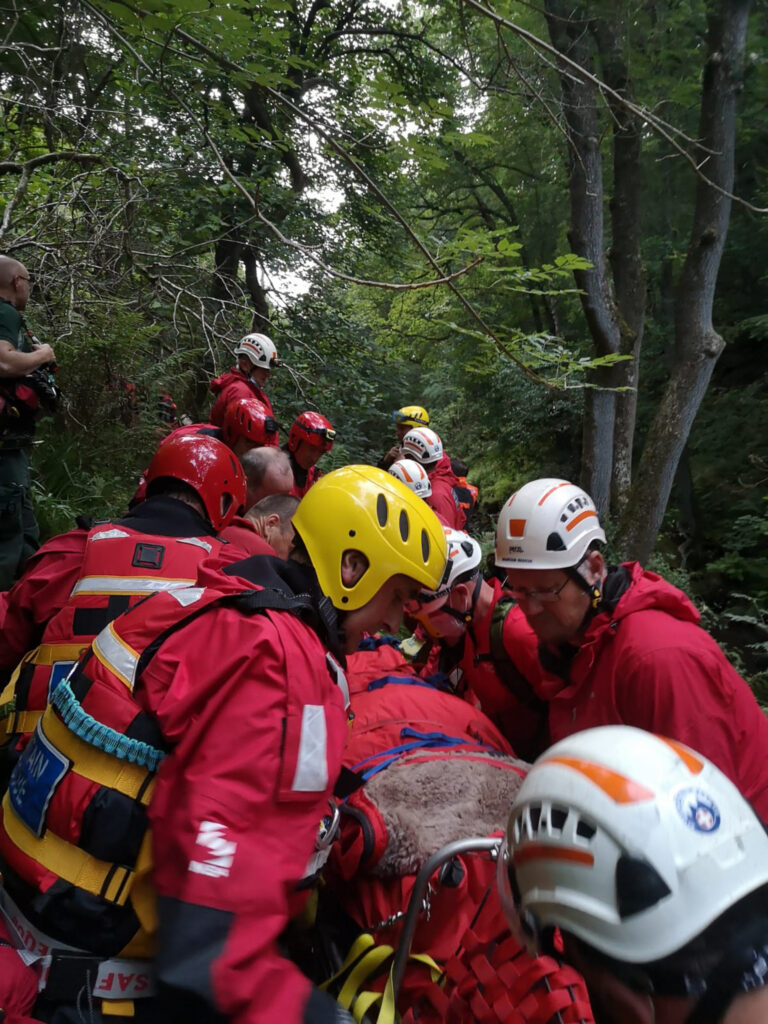
WEDNESDAY 27TH JULY 2022
As normal on a Wednesday evening, at 1800 hours all Team members received a message reminding them to report for training at 1930 hours. However, within a few minutes of that message being sent out those training plans were cancelled when another alert was received – as the Yorkshire Ambulance Service had requested our assistance. They had received a call about a man having reportedly fallen 200-feet down an embankment alongside the River Esk south of Lealholm, between Danby and Egton Bridge.
All available Team members were mobilised together with our two Land Rovers. One of our members who lives fairly close arrived relatively quickly and soon met up with the YAS paramedic and GNAAS paramedic & doctor who were treating the casualty. He was thankfully was not in the river but laid on the bankside rocks. It was not clear how long the casualty had been there but at the time it was thought it may possibly have been for many hours.




Whilst the casualty was receiving treatment for potential multiple chest, shoulder and other injuries, our Team members brought additional equipment including a mountain rescue stretcher. Once he had been stabilised we lifted him onto our stretcher and secured him within a vacuum mattress and a casualty bag. The stretcher was then moved a short distance away from the waterside and temporarily secured using a back-up rope system. Owing to the closeness of the river a number of our members were ‘kitted-up’ in water rescue clothing including dry suits and buoyancy aids.
Our task then was to decide on the best extraction route as there were a few options but none of them was easy – including a steep climb up the embankment using a back-up rope system although the vegetation was very overgrown with many loose rocks. Another option was to have him winched out with Coastguard helicopter that had by then arrived. However, following an assessment on the ground by the helicopter crew that option was discounted owing to the potential danger of flying debris from overhanging trees likely to be caused by the helicopter’s down-draft. So there was mutual agreement between the various services to go for a long ‘stretcher-carry’ back the way that we had walked in – the problem being that it was along a very rough, ill-defined, muddy and undulating narrow path with lots of overgrown vegetation and trip hazards.












It was then a matter of a slow, painstaking and careful carry-out lasting just under one-hour, with eight rescuers handling the stretcher at all times. Sometimes walking, sometimes stationary and passing it ‘hand over hand’ depending on the difficulty of the terrain, taking it in turns to allow sufficient rest for the rescue team including the Coastguard crew who stayed on to help with the carry-out and the YAS paramedics who had a lot of medical kit to carry. Once we reached the end of the difficult forested area (about 350-metres) we then had another 250-metres uphill climb across a field and back to the campsite where we transferred the casualty to the waiting ambulance for onward transport to hospital. We wish him well with his recovery.


The alarm had in effect only been raised when the casualty’s dog was seen alone below a camp site at Wild Slack Farm which is situated at the top of the embankment. It is thought that the dog may have climbed up on hearing voices above which is how people at the top became aware of what had taken place. The dog was very friendly and clearly frightened, cold, hungry and tired but reluctant to leave her owner until coaxed by one of our Team members.


The camp site at Wild Slack Farm proved to be proved to be an ideal RV-point and the support from the farmers and campers was superb – a huge debt of thanks to them! From directing rescuers to the scene to supplying water for the GNAAS crew and dog treats for the casualty’s dog (and taking care of her at the farm). Then when we finally made it back to the campsite and transferred the casualty to the ambulance the farmers and campers had set up a picnic table for us with much needed hot tea and refreshments. After our de-brief we made a point of thanking them all and threw in round of applause for them for good measure.

Photos: Please note when viewing photos: early in to the rescue we dispensed with our normal COVID precautions (facemarks etc) – the conditions were just too hot and humid to wear them throughout and a dynamic risk assessment was made to remove them in the interests of our safety. Similarly, Team members will be seen in various states of dress (including unzipped dry suits) for the same reason.
Many thanks again to our colleagues from YAS, GNAAS and HM Coastguard – a fine example of inter-agency working – and it was great to receive such positive comments from them on the quality of our evacuation work.
Twenty-seven Cleveland MRT members were involved, including our call-out officer who also attended the scene to assist in the rescue phase. The call-out lasted over 5-hours including return travel time.
Applications can be made to join the team in a support role (Operational Support) or as a hill going (Search and Rescue) member.
Applications for either role can be made at any time. Intakes for Operational Support members occur at various times of the year. There is one annual intake for Search and Rescue normally each September.
Join NowThis message is only visible to site admins
Problem displaying Facebook posts.